Tasmania
When you think of Australia as a destination you probably think of sunshine, hot tropical weather, long golden beaches, and the Great Barrier Reef. If you think a bit more broadly, you would think of Uluru, Kata Tjuta, Alice Springs, the dry red deserts of central Australia and indigenous heritage. What you don’t usually think of is experiencing a cool temperate climate, especially in the middle of summer. And yet Australia’s smallest state, Tasmania, has that climate.
Australia is a big country that covers a wide range of latitudes, from almost to the equator in the north, to the mid-temperate zone in the south. Tasmania is an island state off the southern coast of mainland Australia, which is in that temperate zone. Actually, Tasmania is at an equivalent latitude to the south of France, the Balearic Islands, Mediterranean Coast of Spain, and Corsica and Sardinia in the northern hemisphere, but instead of being surrounded by the Mediterranean Sea and large continents, with the warming Gulf Stream nearby, Tasmania is exposed to the cold of the Southern Ocean, which gives it a very different climate.
Because Tasmania doesn't fit the usual expectation of Australia, it's not been such a popular destination. But that is changing rapidly as travellers realise that Tasmania has a lot to offer, in culture, scenery, and experience. So, read my blogs to find out what’s to see and like, here in Tasmania!
Walking on a foggy Kunanyi
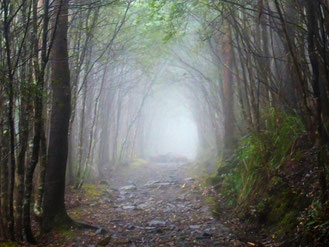
Kunanyi/Mt Wellington is a big part of the soul of Hobart – It’s 1270 metres high, and only eight kilometres from the centre of the city, so it looms over the city, and is visible from just about any part of it.
Our house-sit in Lenah Valley is right under the mountain, so we came up with the idea of travelling to the top (there’s a road right up to the pinnacle) and walking back down through the bush to our house-sit.
School strike for climate action

Last week school students all over the world went on strike to protest the lack of action on climate change. The world's young people are facing life on an Earth that previous generations have severely degraded; the problem is well understood and the effects are so easily observed, there's no excuse for inaction.
While the protest was run by the students, adults were welcome to come along as “supporting adults”, so we went to the protest that was held here in Hobart, Tasmania.
Back in Hobart
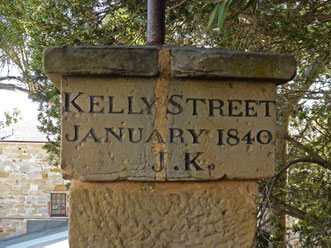
After being away for about six months I am back in Hobart, Tasmania, again for another house-sit, this time in Lenah Valley, in Hobart’s northern suburbs.
We’ve spent our first night in a B and B in Hobart city while waiting for our house-sit to start, so I've had a chance to have a good walk around some of my favourite places in Hobart (I have a lot of favourite places in Hobart): Sullivan’s Cove, Salamanca Place, and Battery Point.
The Penny-farthing championships
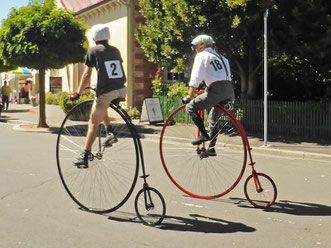
One of the great things about house-sitting is that you are in an area long enough to cross paths with some locally held events. Recently we cross paths with the National Penny-Farthing Championships, which are held in Evandale, Tasmania, not far from our current house-sit.
There are penny farthing races held throughout the day – these bikes are crazy things to watch racing!
A day in Tasmania’s Liffey Valley
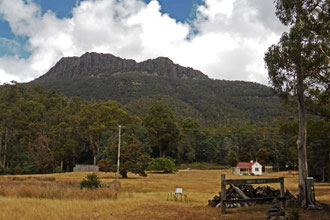
Local markets are one of our favourite ways of interacting with local people as we travel around house-sitting. Yesterday we visited the Liffey Valley Markets in northern Tasmania. To complement our trip to the markets, we had a look to see what else was in the area, and we found that there are some bushland reserves that looked worth a visit.
It turned out to be a great day with lovely experiences and beautiful Tasmanian rural and bush scenery.
Visiting Bridestowe Lavender Estate
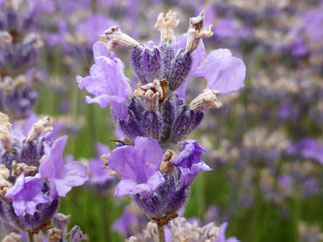
Bridestowe Lavender Estate in the north of Tasmania is one of Tasmania's most popular tourist attractions, attracting visitors from all over Australia and the world. It’s especially popular with Chinese visitors, since visits to the farm by a famous Chinese model and the Chinese president.
We visited recently and thoroughly enjoyed wandering through the rows of lavender!
Rocky Cape National Park

As with most travel destinations, visitors to Tasmania, especially those who are on a tight time budget, head for the well-known attractions such as Cradle Mountain, Freycinet National Park (including Wine Glass Bay), and Maria Island. These are top places on the typical traveller’s ‘must do’ list for good reasons – they are all beautiful places that you actually should see.
Of course, Tasmania has many more beautiful places on offer that are also very much worth visiting – one of my favourites of these is Rocky Cape National Park.
Poppies in Tasmania
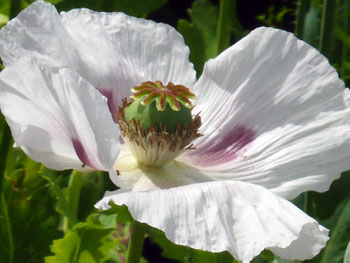
A large part of central northern Tasmania has rich, red, volcanic soil. Much of this beautiful soil is farmland that produces a range of agricultural products including various crops and dairying.
One of the crops commonly grown here is flowers, especially tulips in the spring. Now, in the middle of summer, the flowers that are here are poppies, grown for their opiates.
Hobart street art

If you have ever done a Walking tour of Melbourne you would probably have visited Hosier Lane to see the street art – graffiti-style murals on the buildings of this little back street.
After walking around Hobart many times over the last couple of years I thought I knew it pretty well, but today I was surprised by a pocket of great street art!
Tulips on Table Cape

Much of the Western half of the north coast of Tasmania has deep red volcanic soil. As you pass through the area you see bright green paddocks with sheep and dairy cattle that are making the best of that soil, and ploughed paddocks that reveal the chocolatey red colour of the soil. This marvellous soil in Tasmania’s temperate climate is perfect for growing flowers.
Climbing Mount Barrow
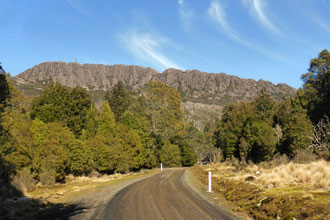
Mount Barrow is one of three large mountains east of Launceston, which can be seen from all over the city. (The others are Mount Arthur and Ben Lomond.)
Mount Barrow is an alpine plateau about 4 kilometres long, with two main summits: Mount Barrow itself, and South Barrow.
I’ve recently climbed Mount Barrow, and explored its alpine plateau.
Climbing Mount Arthur

Mount Arthur is one of several high mountains near Launceston, in northern Tasmania, which I've mentioned in a previous post. I've been thinking about climbing Mount Arthur for a long time, since my house-sit here two years ago; and this time I've got around to doing it.
You can see Mt Arthur from all around Launceston, so I knew from regular observation that it commonly has its head in the clouds.
Walking the South Esk track
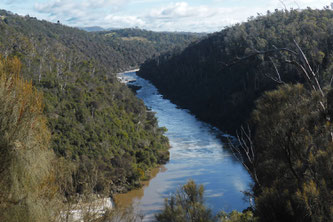
I've bushwalked on the Trevallyn Nature Recreation Area, near the Launceston CBD, many times while house-sitting here.
I thought that I’d pretty much covered all of it; however, I've realised recently that there is one bit of track there I may have never walked on. That track is the South Esk track, which runs along Cataract Gorge, above the South Esk River.
A pastoral walk in northern Tasmania
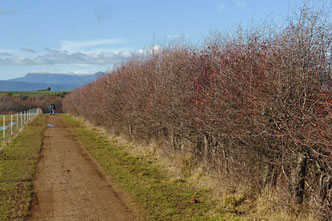
18th-century Britain’s answer to America’s slave trade was convict transportation, and Tasmania has a substantial convict history – convict labour built much of the early infrastructure here.
During Australia's convict period the colonial governments allocated convicts as free labour to landholders, allowing them to develop their estates to become substantial and impressive.
Launceston’s beautiful churches
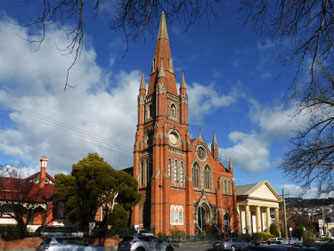
In my previous post, I introduced some of Launceston’s historic buildings, including a few of its commercial historic buildings.
Launceston also has a large selection of another sort of historic commercial building: churches. So much human skill, design, effort, and community wealth went into old churches that they are nearly always beautiful complex, and highly decorated buildings.
Return to Launceston
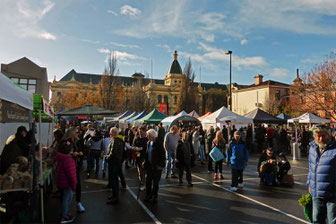
I am back in Launceston, Tasmania, again for another house-sit, a long one this time – about two-and-a-half months.
Launceston is the ‘capital’ of northern of Tasmania. It's a medium-size town with a long European history, set in a beautiful rural and natural setting. Launceston has most of the facilities of a city, plus the countryside and natural world within walking distance of the CBD.
Our House-sit in Mountain River

We are house-sitting in Mountain River, in Southern Tasmania. Our temporary pet this time is Kaya, the Alaskan malamute.
Mountain River district is in the Huon Valley, and it's named for Mountain River, which flows from the alpine plateau of Wellington Park. The main peak of Wellington Park is Kunanyi/Mt Wellington, which forms the dramatic backdrop of Hobart.
It’s a very beautiful area – a rural and wild valley surrounded by beautiful high mountains.
A visit to Ben Lomond
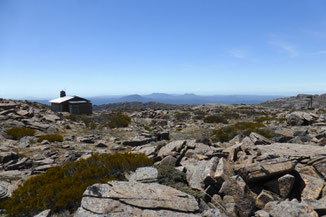
We visited Ben Lomond today, just outside of Launceston. Ben Lomond is one of three large mountain that we see in the view from our house-sit at Trevallyn.
The weather was perfect, and the scenery was dramatic and beautiful with views of the many mountains to the east, the Central Highlands to the west, and Bass Strait to the north.
Our Trevallyn house-sit and its views
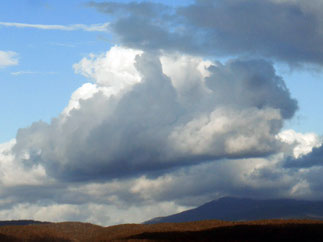
We have moved to northern Tasmania for our current house-sit – we are in Trevallyn, a suburb of Launceston. Trevallyn is on a high ridge to the west of the city, and we are on top of that ridge. Launceston city itself is just a few metres above sea level, but up on the ridge we are 130 metres up, so we get great views of the city and the mountains to the east. It’s a great location; and we are only thirty-five-minutes’ walk from the city centre.
More of Launceston’s Macaque monkeys
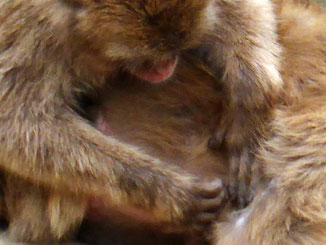
We went into the Launceston CBD today, and we parked near City Park. City Park has a macaque monkey display, which I’ve described in a previous blog post. As always when we are going by, we stopped in on them to see what they were up to, and to catch another revelatory glimpse of their evolutionary connection with humans.
It was a quiet time of day for them, and, in a sense, they weren’t really up to much; but, as always, they do everything, including nothing, in an entertaining way.
House-sitting and kayaking at Beaupre Point

We’ve been house sitting at Beaupre Point, at the end of the Huon Valley, south of Hobart. Beaupre Point is at the confluence of the Huon River and Port Cygnet, so there is plenty of water around. As with our house-sits in Cazorla, Spain, and Marcoola, Queensland, this property is an accommodation business The property has kayaks for the guests to use, and the owners are letting me use one while I’m here, so I’ve taken one out to check out the local waterways.
Climbing Mount Cygnet
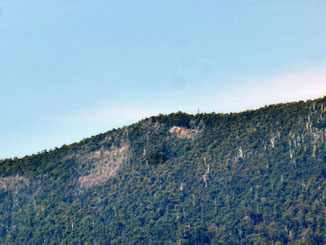
I'm house-sitting in Cygnet, Tasmania, again. This time I'm on the hills looking across Port Cygnet and the inlet. The dominant feature of my view is Mount Cygnet, the summit of a long mountain ridge. You can see Mount Cygnet from all around this area, so, by implication, the view from the top should be extensive. I’ve been eying Mount Cygnet off as a bushwalking destination for a while during my various house-sits here in Cygnet, and I’ve recently worked out how to do it!
Bushwalking in the snow!
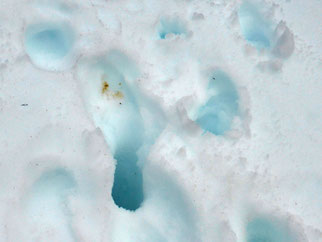
I grew up in sub-tropical south-east Queensland, where there's not a lot of snow, so snow is something of a miracle to me – it's like it's out of a fairy tale. I've been hoping to get to do some bushwalking in snow before this winter is over. I have returned to Tasmania in the early spring, and there's still quite a bit of snow around at high altitudes, so this is my big chance to fulfil that dream.
Climbing Platform Peak, Tasmania
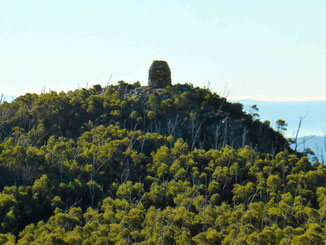
My current house sit in Bridgewater, southern Tasmania, has put me in an area with some great bushwalking opportunities. One of these opportunities is Platform Peak, just outside of the nearby town of New Norfolk.
The walk to platform Peak is through forestry reserve land, which means that it is public land with a low level of environmental protection (it could be logged one day) and minimal walking facilities, such as maintained tracks and sign posting. This means that more care in planning and execution is required, compared with walking in a national park.
The Tasman Bridge Disaster
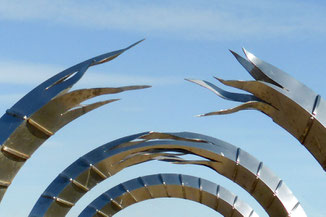
The Tasman Bridge is a graceful bridge that spans the Derwent River, joining Hobart city to the suburbs on the eastern side of the river, to the airport, and to the south-east of Tasmania in general.
The Tasman Bridge was built in 1964 so it’s over fifty years old, but it’s such a modern-looking bridge that it’s hard to believe that it’s as old as it is; certainly, it’s a surprise to see old photos of it covered in 1960s Australian cars, and it’s a surprise to see its original construction cost listed in £s (Pounds), as it was constructed before Australian Dollars came into existence.
But, regardless of the Tasman Bridge’s grace and style, it has a chequered history: it was involved in a serious maritime disaster. If you are in Hobart for long enough you are going to have to hear about, and consider, the story of the Tasman Bridge Disaster.
Climbing the Tasman Bridge
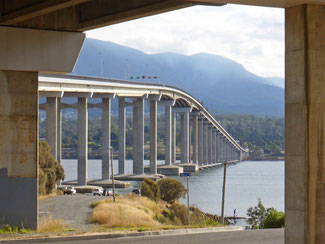
The Tasman Bridge is a long, graceful, and picturesque bridge that spans the Derwent River, joining Hobart to the suburbs on the eastern side of the river.
I’ve driven over the Tasman Bridge many times, as nearly everyone in Hobart and surrounds does, but I’ve never walked over it on its footpaths. I decided to walk over it as it’s quite high and promised the possibility of an interesting experience with good views.
Cornelian Bay boat sheds
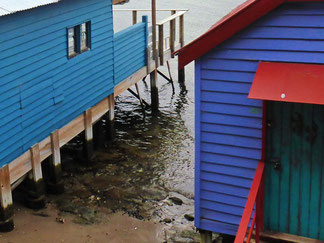
Cornelian Bay is on the Derwent River, just upstream from Hobart and the Tasman Bridge.
There’s a walking path to Cornelian Bay along the foreshore of the river, which runs from the Royal Tasmanian Botanical Gardens. It’s quite a short and easy walk of about five kilometres return.
For the most part the walk is enjoyable but unexceptional – the views are quite urban and even industrial, but nevertheless pleasant and worth seeing. But this little walk does have its special point of interest: a collection of cute boatsheds that step out into the water!
Walking the Alum Cliffs track

One of my favourite types of bushwalking is walking along sea cliffs – I just love peering out of the bush and looking down on that beautiful blue water that disappears into the distance, and seeing the colour of the raw rock of the cliffs against the sea! Southern Tasmania abounds with sea cliffs – some of the highest in the southern hemisphere are down here.
I’ve just walked along the Alum Cliffs, on the Derwent River just south of Hobart, Tasmania’s capital city, and they meet my expectations!
A surprise find: HMAS Curlew
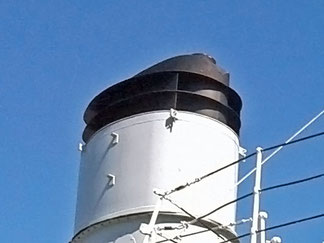
I’ve been kayaking all around Snug while staying in a caravan and cabin park on the foreshore during a short break from house-sitting. The waterways around Snug range in use from relatively wild areas, through agricultural, aquacultural, residential and commercial areas, to industrial areas; so there is a wide range of things to see when out on the water.
Just north of Snug, near Margate, at a marina development, I came across a small and old ex-naval ship tied up at a jetty. At about fifty metres long, while this is a small ship, it is easily the biggest vessel around here, and it was quite a surprise to find it.
Paddling to the Coningham NRA
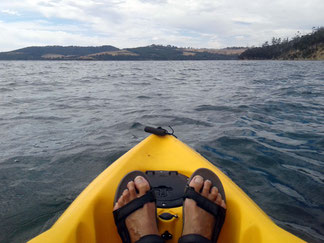
I had a marvellous few days staying at Snug Beach recently, and I was lucky enough to be able to borrow a kayak while I was there. Kayaking is one of my favourite things to do, and my favourite and most adventurous kayak trip while staying at Snug was out to the end of Coningham peninsula, along the Coningham Nature Recreation Area (NRA) – it was also particularly memorable for another reason that I’ll come to. The Coningham Nature Recreation Area is wild and very beautiful – it’s all eroding sandstone cliffs, sandy bays, and bush along the sea edge.
Kayaking at Snug Beach
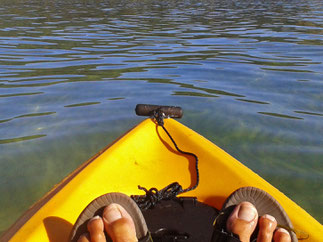
One of my favourite things to do in life is kayaking. I owned a kayak for over twenty years, but when I started this house-sitting tour of Australia I sold it along with our house and car. For many years I had that kayak but little time to use it – now I have the time, and I certainly have the place here in Tasmania, which is a kayaker’s paradise, but I have no kayak! This is why I was excited to find that I was able to borrow a kayak while staying at Snug Beach. Using it was the highlight of my stay, and I thoroughly enjoyed it as I explored the local waterways.
A break at Snug Beach
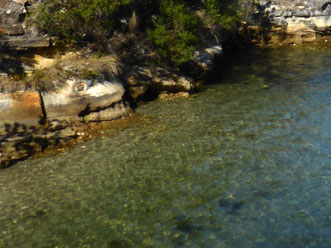
We had a break in our house sitting schedule so we took some time off from looking after pets and cleaning up at the end of a house-sit assignment to stay for a few days in a cabin in Snug Beach Cabin and Caravan Park, a caravan (trailer) park at Snug, a short drive south of Hobart. We had a marvellous stay in a very beautiful and interesting area.
And how cute is the name “Snug”!? It almost beats Flowerpot, a few tens of kilometres further south!
Macaques of Launceston
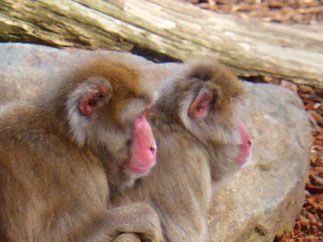
I first visited Launceston nearly 25 years ago, and two things stand out in my memories from that trip: Cataract Gorge and the macaque monkeys in City Park; both of them are still there and they are both still outstanding.
Visiting the monkeys is free, and they are so interesting that we’ve taken to dropping in on them for a look every time we are in that part of the city.
Launceston's Cataract Gorge
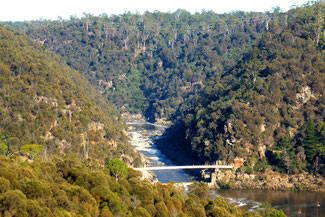
Launceston has an extensive and beautiful natural feature right on the edge of the CBD: Cataract Gorge.
Cataract Gorge was formed when the South Esk River cut through a fault line in a ridge of volcanic rock. It’s a remarkably beautiful and seemingly wild place, especially considering its location right in the middle of a city.
